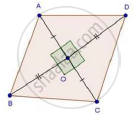Advertisements
Advertisements
Question
Each side of a rhombus is 10 cm. If one of its diagonals is 16 cm find the length of the other diagonal.
Solution

We have,
ABCD is a rhombus with side 10 cm and diagonal BD = 16 cm
We know that diagonals of a rhombus bisect each other at 90°
∴ BO = OD = 8 cm
In ΔAOB, by pythagoras theorem
AO2 + BO2 = AB2
⇒ AO2 + 82 = 102
⇒ AO2 = 100 − 64 = 36
⇒ AO = `sqrt36` = 6 cm [By above property]
Hence, AC = 6 + 6 = 12 cm
APPEARS IN
RELATED QUESTIONS
If the sides of a triangle are 3 cm, 4 cm, and 6 cm long, determine whether the triangle is a right-angled triangle.
In an isosceles triangle ABC, AB = AC = 25 cm, BC = 14 cm. Calculate the altitude from A on BC.
Using Pythagoras theorem determine the length of AD in terms of b and c shown in Figure.
In an isosceles triangle ABC, if AB = AC = 13 cm and the altitude from A on BC is 5 cm, find BC.
In a ΔABC, AB = BC = CA = 2a and AD ⊥ BC. Prove that
(i) AD = a`sqrt3`
(ii) Area (ΔABC) = `sqrt3` a2
In an equilateral ΔABC, AD ⊥ BC, prove that AD2 = 3BD2.
State Pythagoras theorem
Find the length of each side of a rhombus whose diagonals are 24cm and 10cm long.
The co-ordinates of the points A, B and C are (6, 3), (−3, 5) and (4, −2) respectively. P(x, y) is any point in the plane. Show that \[\frac{ar\left( ∆ PBC \right)}{ar\left( ∆ ABC \right)} = \left| \frac{x + y - 2}{7} \right|\]
Find the diagonal of a rectangle whose length is 16 cm and area is 192 sq.cm ?
